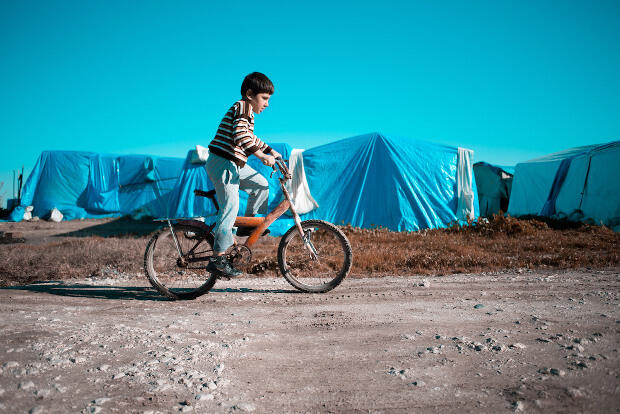
May 1, 2018
How do we view the Syrian refugee crisis? A new study looks to Instagram and Pinterest for answers
Share this story
As millions of Syrians have fled their country’s civil war, the influx of refugees has prompted both humanitarian efforts to help them as well as growing views of refugees as a threat to the receiving countries’ security and autonomy.
Sentiments about the refugee crisis are increasingly expressed on social media. A new study led by Jeanine Guidry, Ph.D., an assistant professor in the Richard T. Robertson School of Media and Culture in the College of Humanities and Sciences, provides new insight into what and how information about Syrian refugees is being shared.
The study, “Welcome or Not: Comparing #Refugee Posts on Instagram and Pinterest,” was a quantitative content analysis of a random sample of 750 Instagram posts and 750 Pinterest posts to evaluate and compare visual and textual messaging surrounding the crisis.

Along with Guidry, the study was conducted by an interdisciplinary team of researchers, including Kellie Carlyle, Ph.D., associate professor in the Department of Health Behavior and Policy in the School of Medicine; Marcus Messner, Ph.D., associate professor in the Robertson School; and Lucinda Austin, Ph.D., assistant professor at the University of North Carolina; Karen Freberg, Ph.D., associate professor at the University of Louisville; and Yan Jin, Ph.D., and Michael Cacciatore, Ph.D., at the University of Georgia.
Guidry recently discussed the team’s study, which was published over the weekend in the journal American Behavioral Scientist.
You analyzed posts on Instagram and Pinterest about Syrian refugees. What did you find? Were there differences in how people discussed the crisis between the two platforms?
We looked at a lot of different variables — both image and text-based. One of the main things we coded for was this: Was the main concern of the Instagram or Pinterest post “humanitarian concern” (e.g., refugees portrayed to be in need of our help and assistance, either as a nation or as individuals) or “security concern” (e.g., refugees portrayed to be a threat to our security as a nation or as individuals) in nature?
What we found is that Pinterest posts focused more on the “security-concern” variables, while Instagram focused more on the “humanitarian-concern” variables. Posts with humanitarian-concern sentiment elicited more engagement and discussion across both platforms, and Instagram posts produced more engagement overall than Pinterest posts.
We also looked at how these stories were told: stories of individual refugees and refugee families — what we call using episodic framing — or framing the refugee issue using statistics and the broader societal issues — called thematic framing. We found that security-concern posts were more likely to be framed thematically; and humanitarian-concern posts more frequently told stories of individual refugees or refugee families.
Finally, we found that visuals in humanitarian-concern posts — particularly on Instagram — were surprisingly lacking in intensity, compared to the intensity of text captions, which suggests an opportunity for more effective messaging through the increased use of relevant visuals.
What are the implications of your findings?
I think the first implication is that it confirms, again, that different platforms are used differently, and in part, that is likely due to who uses these platforms. One of the reasons why this study was so fascinating is that it focused on two visual social-media platforms, Instagram and Pinterest, that so far have not been studied as frequently as Facebook and Twitter. We know that people process visuals differently than text, and it’s important to study visual messages and engagement with these messages online.
Why is it important for us to understand what people are saying on social media about the Syrian refugee crisis?
Social media platforms provide a window into at least part of the public’s sentiment on a wide variety of issues.
Social media platforms provide a window into at least part of the public’s sentiment on a wide variety of issues — and it does not look like the ongoing Syrian refugee crisis is going to be resolved anytime soon. Knowing what the public’s sentiments are related to such a high-profile issue may help organizations address specific concerns.
In the first three months of 2018, the United States accepted 11 refugees from Syria, after accepting 3,024 in 2017 and 15,479 in 2016. In the context of this study, what do you think about how the U.S. is increasingly shutting the door on Syrian refugees?
Looking at the images in this study and particularly the stories of refugees and refugee families emphasized for me that, while of course we need to be security conscious, this is such an enormous humanitarian crisis, and one that may be hard to fully grasp for many of us. I don’t know the solutions because these are complex international issues, but I know that this is something that can only be addressed by the global community, and I wholeheartedly hope that relief will come for refugees still in refugee camps or in another form of limbo.
Anything else you'd like to add?
Instagram and Pinterest will likely reach and engage different population segments, and communication professionals should not rely exclusively on one strategy or platform to influence refugee-focused conversations and representations on social media.
Subscribe to VCU News
Subscribe to VCU News at newsletter.vcu.edu and receive a selection of stories, videos, photos, news clips and event listings in your inbox.





